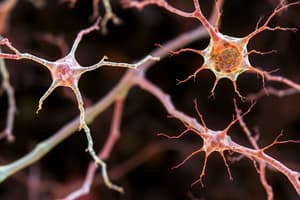Podcast
Questions and Answers
What is the main function of astrocytes in the central nervous system (CNS)?
What is the main function of astrocytes in the central nervous system (CNS)?
- Regulate nutrient supply and structural support (correct)
- Provide myelin sheaths for axons
- Manufacture neurotransmitters exclusively
- Scavenge and degrade dead cells
How do oligodendrocytes differ from Schwann cells in their function?
How do oligodendrocytes differ from Schwann cells in their function?
- Oligodendrocytes myelinate multiple axons, while Schwann cells myelinate only one. (correct)
- Oligodendrocytes are found only in the peripheral nervous system.
- Oligodendrocytes supply nutrients to capillaries, unlike Schwann cells.
- Oligodendrocytes form the blood-brain barrier, while Schwann cells do not.
What role do microglia play within the nervous system?
What role do microglia play within the nervous system?
- Provide myelin for neuron axons
- Facilitate synaptic transmission
- Regulate blood flow to neurons
- Act as immune defenders by removing dead cells (correct)
What is neurogenesis?
What is neurogenesis?
Which type of glial cell is primarily responsible for forming the blood-brain barrier?
Which type of glial cell is primarily responsible for forming the blood-brain barrier?
What is neuroplasticity?
What is neuroplasticity?
Which glial cell type is involved in the production of cerebrospinal fluid?
Which glial cell type is involved in the production of cerebrospinal fluid?
What is the approximate ratio of glial cells to neurons in the nervous system?
What is the approximate ratio of glial cells to neurons in the nervous system?
What occurs when a neuron is sufficiently stimulated?
What occurs when a neuron is sufficiently stimulated?
During the resting state, what is the concentration of Na^+ ions compared to K^+ ions?
During the resting state, what is the concentration of Na^+ ions compared to K^+ ions?
What is the term for the brief period during which the neuron cannot generate another action potential?
What is the term for the brief period during which the neuron cannot generate another action potential?
What is the All or None Principle in relation to action potentials?
What is the All or None Principle in relation to action potentials?
What happens to the ionic balance after an action potential is produced?
What happens to the ionic balance after an action potential is produced?
What does the term 'graded potential' refer to?
What does the term 'graded potential' refer to?
What role does the myelin sheath play in neuronal function?
What role does the myelin sheath play in neuronal function?
What is the peak positive voltage during an action potential supposed to reach?
What is the peak positive voltage during an action potential supposed to reach?
Flashcards are hidden until you start studying
Study Notes
Glial Cells
- Support neurons and hold them in place, often referred to as "glue" of the nervous system.
- Manufacture nutrient chemicals essential for neuron function.
- Absorb toxins and waste materials, preventing potential harm or neuron death.
- Outnumber neurons approximately 10 to 1.
- Guide the development of neurons to their designated locations.
- Form myelin sheaths around axons, enhancing the speed of electrical impulses.
- Play a role in modulating communication between neurons, responding to nerve activity.
- Most brain tumors originate from mutations in glial cells.
Types of Glial Cells
- Astrocytes: Provide structural support, regulate ion concentrations, and contribute to the blood-brain barrier.
- Microglia: Act as immune defense, scavenging dead cells and defending against microorganisms.
- Oligodendrocytes: Form myelin sheaths around axons in the CNS, capable of myelinating multiple axons.
- Schwann Cells: Myelinate single axons in the PNS, fully surrounding each axon.
- Ependymal Cells: Line the brain's ventricles, involved in cerebrospinal fluid production, and maintenance.
- Radial Glia: Serve as scaffolding for neuron migration during development.
Neurogenesis and Neuroplasticity
- Neurogenesis: The formation of new neurons, recognized in the healthy adult brain since the 1990s.
- Neuroplasticity: The brain's ability to adapt, form new connections, and rebuild pathways in response to new information.
Electrical Activity of Neurons
- Neurons generate electricity, which creates nerve impulses.
- Resting Potential: At rest, a neuron's membrane is polarized, with a negative electrical charge (approximately -70 mV).
- Action Potential: Occurs when stimulated; sodium ions (Na+) flow into the neuron, reversing its charge to about +40 mV.
- Three basic steps of nerve activation:
- Resting potential maintenance.
- Depolarization driven by sodium influx.
- Restoration of ionic balance post-action potential.
- Action potentials spread down the axon to axon terminals, followed by a refractory period where the neuron cannot fire again immediately.
All or None Principle
- Action potentials either occur at maximum intensity or not at all, requiring a threshold of +50 mV to trigger.
- Graded Potential: Changes in resting potential that do not reach the threshold for an action potential can't trigger a nerve impulse.
Myelin Sheath
- A whitish, fatty layer derived from glial cells that insulates axons during development, significantly increasing nerve impulse transmission speed.
Studying That Suits You
Use AI to generate personalized quizzes and flashcards to suit your learning preferences.



